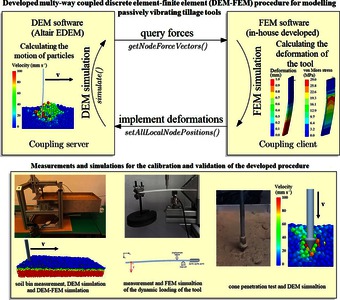Pásthy, László and Farkas, Zsolt and Haba, Tamás and Tamás, Kornél (2023) Development of a multi-way coupled discrete-finite element method simulation procedure for modelling soil-passive vibration tool interaction. COMPUTERS AND ELECTRONICS IN AGRICULTURE, 2016. No.-108459. ISSN 0168-1699
|
Text
multi-way coupled discrete-finite element method.pdf - Published Version Available under License Creative Commons Attribution Non-commercial No Derivatives. Download (17MB) | Preview |
|
![[img]](https://real.mtak.hu/204396/7.hassmallThumbnailVersion/graphical%20bstract.jpg)
|
Text (graphical abstract)
graphical bstract.jpg Download (245kB) | Preview |
Abstract
Among the energy-saving tillage solutions, a promising technology is the application of passive vibration-based soil tillage tools. If the appropriate tillage parameters are applied, a tillage tool which involves vibration-based motion can reduce the draught force and energy requirements of the tillage process while enhancing its quality. The main focus of our research was on developing a coupled discrete-finite element procedure to investigate the interaction between passively vibrating tools and the soil. To validate this method, a soil bin measuring system was constructed to investigate the operation of a highly rigid structural steel (S235) tool along with a more flexible polymethyl methacrylate (PMMA) tool, with the soil bin at working depths of 18, 30, and 42 mm, tool velocities between 28 and 37 mm s−1, in sandy soil with 1 ± 0.1 % dry based moisture content. Soil bin measurements with the highly rigid S235 tool were simulated using the discrete element method (DEM) along with a coupled discrete-finite element (DEM-FEM) procedure, while the soil bin measurements applying the more flexible PMMA tool were simulated using the coupled DEM-FEM procedure. In the case of DEM calculations the hysteretic spring and linear cohesion contact models were applied, and in the case of FEM calculations the transient, linear elastic model was utilised with Rayleigh damping. During the parameter calibration process it was observed that the soil properties depend on depth, therefore a multi-layered soil model was created. After parameter calibration the simulated mean force and deformation values matched the measured values with less than 15 % difference. Furthermore the simulation results also supported the assumption that passively vibrating tillage tools loosen and mix the soil more effectively. Based on these results, it can be concluded that the coupled DEM-FEM procedure enabled the accurate modelling of passively vibrating tillage tools.
| Item Type: | Article |
|---|---|
| Uncontrolled Keywords: | DEM, FEM, Coupling, Vibratory tillage, Passive vibration |
| Subjects: | S Agriculture / mezőgazdaság > S1 Agriculture (General) / mezőgazdaság általában |
| Depositing User: | Dr. Kornél Tamás |
| Date Deposited: | 06 Sep 2024 12:41 |
| Last Modified: | 06 Sep 2024 12:41 |
| URI: | https://real.mtak.hu/id/eprint/204396 |
Actions (login required)
 |
Edit Item |




